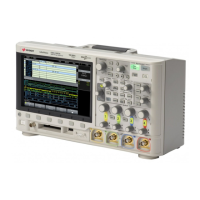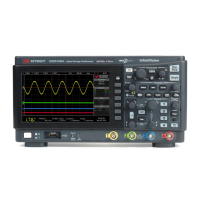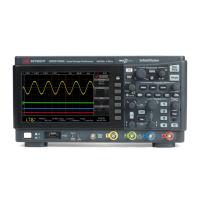66 Keysight InfiniiVision 3000T X-Series Oscilloscopes User's Guide
2 Horizontal Controls
Everything to the right of the trigger point is called post-trigger information. The
amount of delay range (pre-trigger and post-trigger information) available
depends on the time/div selected and memory depth.
The horizontal position knob works (in the Normal time mode) while acquisitions
are running or when they are stopped. When running, adjusting the horizontal
scale knob changes the sample rate. When stopped, adjusting the horizontal scale
knob lets you zoom into acquired data. See “Panning and Zooming Single or
Stopped Acquisitions" on page 66.
Note that the horizontal position knob has a different purpose in the Zoom display.
See “To display the zoomed time base" on page 71.
Panning and Zooming Single or Stopped Acquisitions
When the oscilloscope is stopped, use the horizontal scale and position knobs to
pan and zoom your waveform. The stopped display may contain several
acquisitions worth of information, but only the last acquisition is available for pan
and zoom.
The ability to pan (move horizontally) and scale (expand or compress horizontally)
an acquired waveform is important because of the additional insight it can reveal
about the captured waveform. This additional insight is often gained from seeing
the waveform at different levels of abstraction. You may want to view both the big
picture and the specific little picture details.
The ability to examine waveform detail after the waveform has been acquired is a
benefit generally associated with digital oscilloscopes. Often this is simply the
ability to freeze the display for the purpose of measuring with cursors or printing
the screen. Some digital oscilloscopes go one step further by including the ability
to further examine the signal details after acquiring them by panning through the
waveform and changing the horizontal scale.
There is no limit imposed on the scaling ratio between the time/div used to
acquire the data and the time/div used to view the data. There is, however, a
useful limit. This useful limit is somewhat a function of the signal you are
analyzing.
